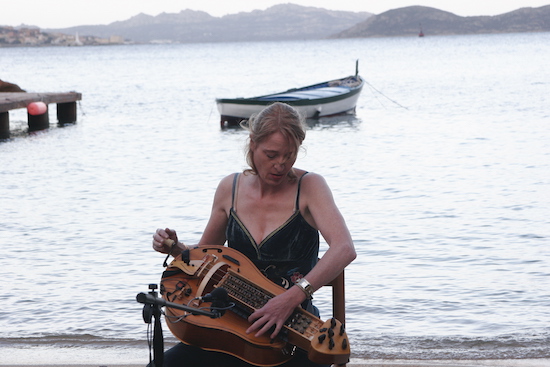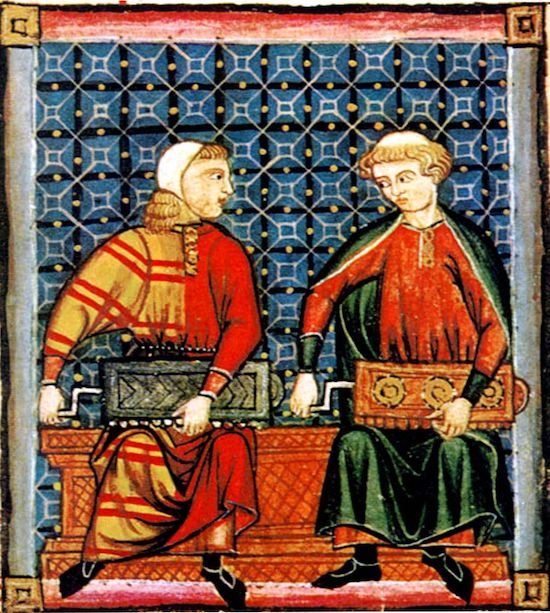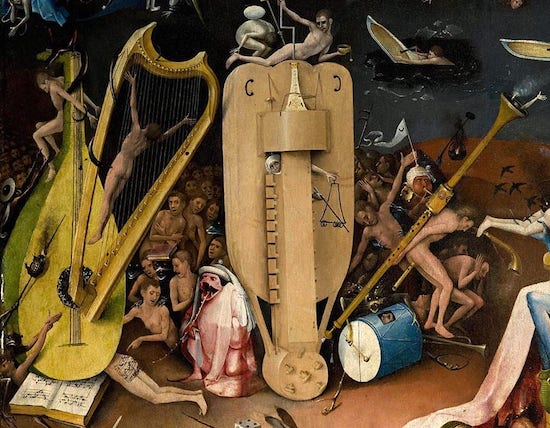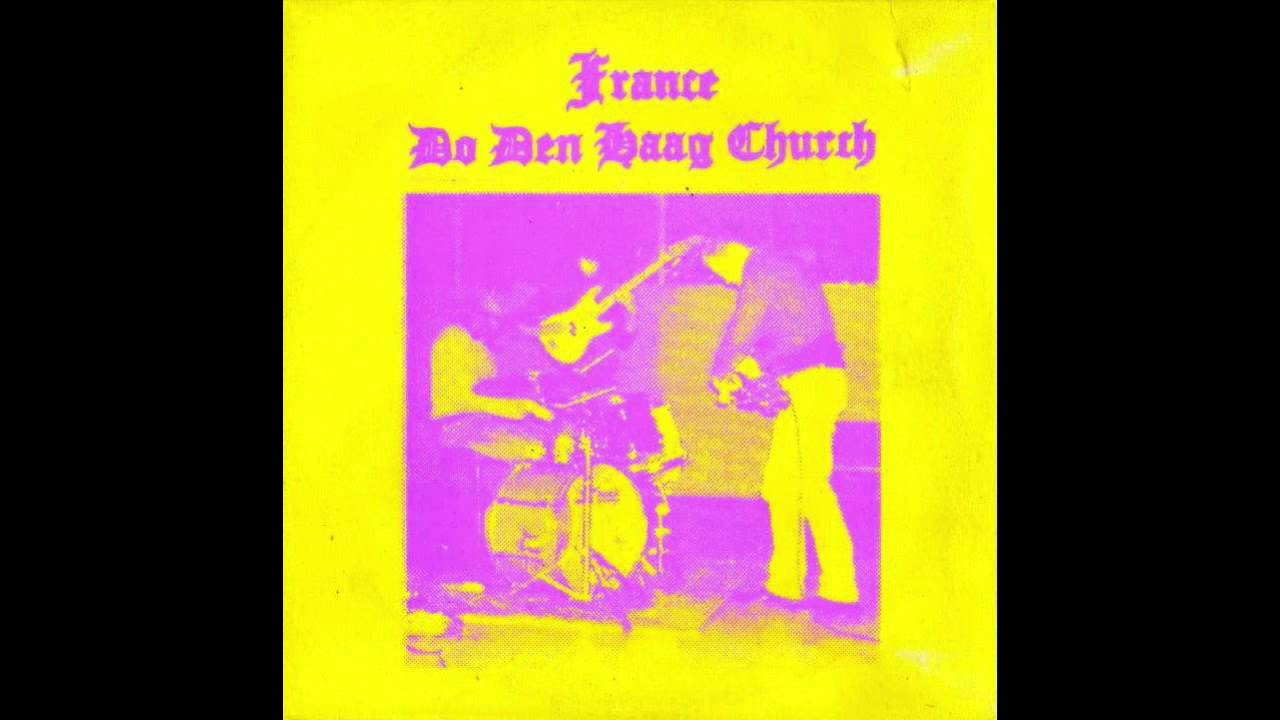A hurdy-gurdy sounds like medieval Sunn O)); like a parade come to collect you for the eternal hot licks of the underworld; like a squall of wraiths; like a horde of horrifying troubadours in animal heads singing your sins; like the wheezing exhalations of the pained geologic earth itself. The hurdy-gurdy is "the Ur-industrial instrument par excellence," wrote Biba Kopf in the sleevenotes to one of Keiji Haino’s three hurdy-gurdy albums. If you think that sounds a bit much, consider that this is an instrument with more drone strings than melody strings, capable of creating a deafening hellscape in the right hands. In Hieronymus Bosch’s Garden of Earthly Delights the soundtrack to hell is a giant and infernal hurdy-gurdy, accompanied by a large lute, a harp, and a man playing a recorder out of his bum.
I first encountered the hurdy-gurdy via a CD rip of one of the albums Haino made as ‘The 21st Century Hard-Y-Guide-Y Man’, its bizarre punned title scrawled on a CD-R in black marker. The Japanese underground musician made its wooden body and strings sound like metal on metal, exploiting its capacity for overwhelming density and ferocity; for blood-curdling rasping that jangles the nerves, and for soft and mournful keening.
A hurdy-gurdy is a medieval instrument that in its basic shape vaguely resembles a violin or a lute, only everything is chunkier, fatter, and it is played differently to other stringed instruments. It is held on the knee, rather than under the chin, and it produces sound by a hand-cranked handle, which turns a rosined wheel that rubs against strings – melody strings and drone strings. Keys can be pressed to play a melody, and the wheel functions like a violin bow. Because of the wheel, the pressure on the strings is constant, although when the handle is vigorously turned, a buzzing bridge called the dog, or trompette, vibrates against the body, giving it the anxious, biting sound that Haino literally leans into.
The undoubted master of the hurdy-gurdy in the UK is Stevie Wishart, who plays both traditional early music and contemporary experimental music. She says the hurdy-gurdy is like "an acoustic synth" and says it was this that first caught her ear about the instrument. "Its sound is all about filtering the frequencies with the wheel-speed and playing with finger pressure directly on the strings as noise harmonics," she explains, "as well as the normal musical notes played with the keys.

"Technically it’s really special. It defies our standard categorisation, since it is neither a keyboard instrument not a string instrument but a mishmash of both, and to cap it all, is unique in being bowed with the rim of a wheel."
Wishart says that in folk and traditional music playing the buzzing bridge is part of a controlled technique – a refined and sometimes pretty part of a composition. But for contemporary and experimental players, it is the feral edge that gives the hurdy gurdy its bite. This buzzing bridge also adds another similarity to electronic music. Wishart says that as a multi-instrumentalist with a background in electronic music, she finds this bridge to be a lot like an in-built acoustic version of a Big Muff distortion pedal. Lots of medieval and renaissance instruments used to have this sort of timbral complexity built into their sound, she explains "before they had their act cleaned up by being included as members of the orchestra".
The horror and despair in the sound of a hurdy-gurdy, the patina of its melodic textures and its unearthly drone mean that the instrument has often cropped up, hundreds (if not over a thousands) years after it emerged, in the Japanese underground, British industrial music, with modular synths or in psychedelic jams. As well as Haino’s albums, you can hear it in Cyclobe, Matmos, in the un- psychedelic jams of un-Googleable French band France, among others.
It is its hand crank operation that lends the hurdy-gurdy its haunting nature – it does not produce a solid drone but breathes in uncanny rhythms; it has an accent, one shaped by the person that turns the handle. This also means that the heavy circular psych-dirges of France (think extended versions of Tony Conrad & Faust) the music can continue for hours – nobody runs out of puff playing a hurdy-gurdy. The relentless and obliterating churn of a recording like France at Do Den Haag Church ought never to end:
France’s hurdy-gurdy player, Yann Gourdon, plays an amplified French hurdy-gurdy (a vielle à roue), harnessing its raw acoustic energy into a full-frequency muscular beast. Gourdon’s playing began in traditional music from Auvergne in central France where, historically speaking, the hurdy-gurdy is particularly prevalent, and now applies it to huge drones:
Donavon, arguably, did the biggest damage to the hurdy-gurdy in the near-nonsense bendy acid pop song Haino takes his pun-tastic title from (which contains such lyrical nuggets as “Roly poly, roly poly, holy poly poly, he sang”). The worst part is, ‘Hurdy Gurdy Man’ doesn’t actually have a hurdy-gurdy in it at all, its weighty drone in fact made by an Indian tambura. Donovon claims not only that this session was the spark that came to ignite Led Zeppelin, but was also the moment in which he says, inexplicably, Celtic rock was invented, somewhat erasing the role of the Indian drone instrument that gives the song its weight.
The hurdy-gurdy is, it’s fair to say, one of the whitest instruments around. Unlike most stringed instruments, which are Arabic by descent, the hurdy-gurdy is thought to be European in its origins. There is evidence that it has been in constant use in Europe for a thousand years, and was widely known by about the mid-12th Century. It was prevalent in Central and Eastern Europe – there is the Ukrainian lira, Slovakian ninera, the Hungarian tekerolant, as well as types of hurdy-gurdy in Russia, Spain, Italy and the UK. And that’s before we get started on variations like the dulci-gurdy (half dulcimer, half hurdy-gurdy). As well as in Bosch’s 16th Century painting, there are hurdy-gurdies in etches by Rembrandt, and in an illuminated illustration from the Cantigas de Santa Maria – the early music bible – where two hurdy-gurdy players side-eying each other mischievously as if about to bring down the house for an unsuspecting audience.

It was not possible to escape the jaunty music of the traditional hurdy-gurdy player on the streets of 19th century London, where they could be heard along with singers, violinists, actual mechanical organ grinders (with monkeys) singers from Italy, Ethiopian serenaders, brass bands from Germany, and Scottish bagpipers. In 1851, in his proto-sociological study of the poor and labour in London, Henry Mahew reckoned there were a thousand street musicians working in the city, with a good number of hurdy-gurdy players. One blind player encountered by Mayhew had worked the streets in the city for 40 years. Because of its volume, its players were one of the targets (often confused and grouped in with barrel organ players) of 19th century noise complaints about street musicians, who rattled the nerves of the petty bourgeoisie with a din of persistent playing, and were known to start up a song at all hours. The thing that makes it so appealing to experimental musicians now – particularly to those looking to bring up a squall of sound that can be maintained for a very long time – is precisely what meant it shredded the nerves of the 19th century gentility. Traditional hurdy-gurdy songs, like <a href-"https://folkways.si.edu/henri-vasson/hurdy-gurdy-music/world/music/album/smithsonian" target=”out”>>this one on Folkways by French folk player Henri Vasson are sinewy and gangly creatures in comparison to the muscular reps of something like France, although they share a regional identity.
It was the Balkan style of playing that excited Ossian Brown, one half of the English experimental duo Cyclobe and a member of Shirley Collins’ live band. In an interview with The Quietus , Brown said he had been in awe of the hurdy-gurdy from the moment he heard it in a 1970s BBC adaptation of M.R. James’s Lost Hearts, "which has a fantastically chilling scene of a strange blue ghost child playing hurdy-gurdy at the foot of a young boy’s bed". It was, he said, "immensely haunting" but compelling in a way that sparked his curiosity. He subsequently searched it out in early Baroque music and traditional and provincial folk music from France. He eventually found “a marvellous and extremely beautiful Vielle à roue” made by Pajot, in the mid 1800s – a famous family of French makers who built instruments in Jenzat, France from the end of the 18th Century up until WWII. Brown said that he was most strongly drawn to Hungarian and Ukrainian folk music, played mostly by peasants, labourers or travelling street musicians. “I found the way they played, taking a raw and less ornamental approach, very exciting,” he explained. Brown’s hurdy-gurdy composition ‘The Split Ash Tree’ was a highlight of Shirley Collins’ comeback album Lodestar:
Wishart comparing the hurdy-gurdy’s sound to synths and pedals perhaps renders Matmos’s pairing of the instrument with modular synths on The Civil War album less surprising than it was back in 2003. Because their hurdy-gurdy didn’t have the ‘dog’, they reconstructed it electronically and bent the left and right channels out of line with one another for the track ‘Regicide’. In an interview at the time Daniel describes these divergent gurdies as sounding "like the floor in the room is tilted, or the tape is getting chewed up".
While the hurdy-gurdy’s capacity to fill space with its unrelenting multi-tonal dirge is for some the absolute sonic dream, for others it is the stuff of nightmares. Its distinctive sound, made by those technical restrictions mean it often doesn’t quite fit in a group, and Wishart pointed out that its complex construction and confusing playing technique also does not lend itself to musical notation. Its grating, rasping bark also means it cuts through anything it plays with – she says she’s even occasionally broken tweeter speakers in the studio when recording. When considered like this, it’s no surprise that experimental musicians have picked up on the hurdy-gurdy’s uniqueness, what, as Wishart says, makes its sound "as old as it is new".
The hurdy-gurdy can creep, or it can pounce, and that buzzing dog has teeth. It might sound more like a horde of infernal players from hell than a single hand cranked instrument, but herein lies its power. Wishart thinks that because of these various peculiarities, the hurdy-gurdy has been free to roam in a way other instruments can’t. It is out on its own, she says, "something of a cultural and social nomad – a free-musical spirit".






